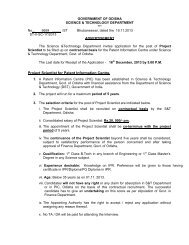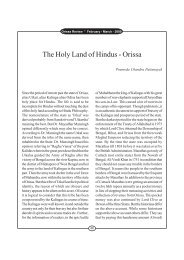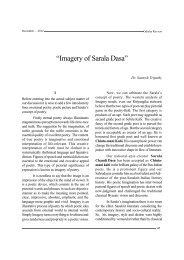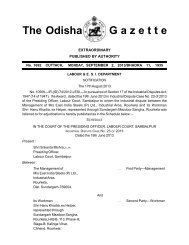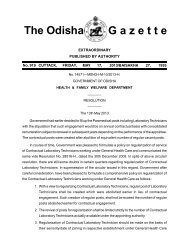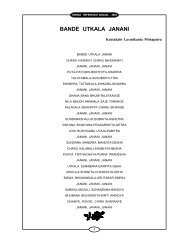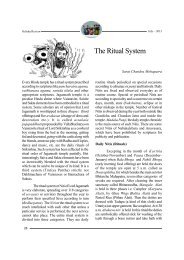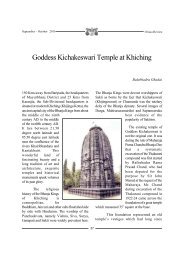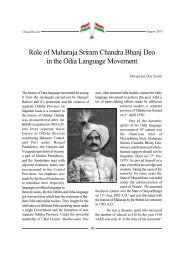ARM COLLECTIONS IN THE ORISSA STATE MUSEUM
ARM COLLECTIONS IN THE ORISSA STATE MUSEUM
ARM COLLECTIONS IN THE ORISSA STATE MUSEUM
You also want an ePaper? Increase the reach of your titles
YUMPU automatically turns print PDFs into web optimized ePapers that Google loves.
OHRJ, Vol. XLVII, No. 2<br />
<strong>ARM</strong> <strong>COLLECTIONS</strong> <strong>IN</strong><br />
<strong>THE</strong> <strong>ORISSA</strong> <strong>STATE</strong> <strong>MUSEUM</strong><br />
R. K. Mishra<br />
The story of weapons is intimately connected with the story of mankind. Born<br />
armed but not weaponed man is obliged to arm himself with weapons both for the<br />
purpose of offence and defence. The arming of man all over the world began in the<br />
remote past when the primitive man fashioned crude weapons from pebbles and stones<br />
not only to protect himself from the ferocious beasts but also to augment his food supply<br />
by hunting. With the passage of time he brought about sophistication in them and used<br />
these weapons for all his domestic and external needs. With the gradual development<br />
and discovery of mater like copper and bronze (C.2500 B.C. in India), he hammered or<br />
cast his metalic weapons which he used to greater effect when iron came to be known<br />
in India around 1000 B.C. it brought about a revolution in the art of weaponry. Several<br />
kingdoms were razed to the ground and vast empire built on their ruins with the power<br />
of the weapons.<br />
This study of Arms and Weapons absorbs interest to a large and ever increasing<br />
number of people inasmuch as it appeals in a marked degree to a student of history, the<br />
antiquarian and to those who worked in the art of military science.<br />
Weapons form the basis for a certain aspect of history and pre-requisite for changing<br />
the face of the world through various wars. This study constitutes a subject in writing the<br />
history of a nation.<br />
Orissa State Museum has acquired a good number of traditional weapons of war<br />
like swords, guns, cannons, daggers, spears, bows, battle axes, shields, etc. These<br />
weapons are under display in a separate Armoury Gallery.<br />
Representing several varieties, the Museum has choicest species of swords and<br />
talwars which are generally carved towards the end and has cutting edge. The Khadga<br />
variety of swords normally straight with blunt end and having double cutting edges. It is<br />
usually very heavy. Patta forms another type with a long handle and can pierce through<br />
the body of the enemy. There are two inscribed swords collected from Narasinghpur and<br />
Baramba Palace which deserves special mention. The first one belongs to Muslim<br />
Period having curved with hilt, oval grip and straight quillion. The back edge bears a<br />
persian inscription having an inscribed name of ‘Saha Alam Badshah’.<br />
87
OHRJ, Vol. XLVII, No. 2<br />
The second one belongs to Gajapati Period. The hilt has a brass grip with gold<br />
coated inscription beginning with “Om Ganesayah Namah” in proto Oriya character and<br />
presumably a verse from Vishnu Sahasranama. The use of jewels like gold coating in<br />
arms is peculiar in India. These are studded to enhance the beauty, elegancy and richness<br />
of the swords. The hilts of the swords are fashioned with costly metal with engraving of<br />
floral devises and animal figures. The blades have decorated designs and inscribed<br />
letters. The greatest amount of ornamentation is lavished upon armours and personal<br />
weapons of kings and emperors. Some metalic weapons are engraved, enamelled,<br />
perforated and embelished in many forms. Some of the hilts are made of ivory, steel ,<br />
horn, fish teeth, etc.<br />
The gallery is enriched with display of varieties of matchlocks, flint guns, muzzle<br />
load and rifles. The Marahattas used matchlocks, pistols and rifles. These guns are<br />
generally large and heavy. The long barrel of the matchlock is usually attached with the<br />
stock by leather stripe and strengthened with side plates of steels. These are traditional<br />
types used by the soldiers of the royal armies during these days. Gun powder is generally<br />
pressed inside their long barrels and then fired. The prize collection in the gallery is the<br />
personal gun of Utkal Gaurav Madhusudan Das, the maker of Modern Orissa.<br />
There are about 30 numbers of small and big cannons displayed in the gallery.<br />
These fire arms are generally of Mughal and Marahatta Period. It may be mentioned<br />
here that the development of fire arms made Mughals very effective. Guns and cannons<br />
mounted each on a wheel carriage were later introduced from Europe and convenient<br />
devices were added in the Mughal Army by Akbar. Eight big cannons were recovered<br />
from Barabati Fort area of Cuttack district and brought to the Museum. Two big cannons<br />
were brought from Lalbag Palace, Cuttack at the instance of Shri A. N. Khosla the then<br />
Governor of Orissa during 1969. Lalbag originally a seat of Mughal Governors was<br />
subsequently converted to Governor House of Orissa.<br />
Ten number of daggers have been displayed in the gallery. Some of the daggers<br />
are assorted variety with hilts of ivory bones, agate and metal. Some daggers are curved<br />
and straight. Jamdhar, a popular variety of daggers have a beautiful handle and broad<br />
straight blade. The blade is thick with two cutting edges having a breadth of three inches<br />
at the hilt. The handle bars are very often enamelled and display decorative designs.<br />
Spears and javelines are coveted weapons for riders and cavaliers and fixed to<br />
the saddle through iron chains. Ballam which were another popular variety consisted of<br />
several varieties. They are constituted of metal and are very slender and could easily be<br />
thrown. The blade is round in two sides, three sides and even more. The blade is in the<br />
shape of vertical narrow leaf. The blade of those weapons are attached to long bamboo<br />
and hurled on the foe when they are used for attack. The State Museum preserves a<br />
good number of these weapons datable to Mughal and Marahatta Period. Some of them<br />
88
OHRJ, Vol. XLVII, No. 2<br />
have been provided with a leather strap to facilitate their hanging from shoulder of the<br />
armed personnel. The shafts of many of these weapons are decorated with gold and<br />
silver workmanship.<br />
Among the defensive weapons in the collection there are circular shields of different<br />
varieties made of hide and metals to protect the body from close range when attacked<br />
by the enemy.The shields are made of the skin of Rhinoceros, buffalo, tortoise, tigers<br />
and are elaborately decorated and damascened with gold, cresents and murals. At<br />
subsequent periods metal seems to have been used in the fabrication of shields with<br />
both iron and copper. The shape of the shields are ordinarily circular. The diametre<br />
ranges from 18th to 20 inches. At time they are fitted with four or six steel brussed on<br />
thin surface.<br />
The gallery is enriched with good collection of battle axes. Axes are dreadful<br />
weapons which could create havoc when used in the war but in later period they were<br />
outdated. The battle axe consisted of a short wooden shaft with a shouldered blade<br />
attached to it on the side near the top. The battle axes were very much prevelent among<br />
soldiers of Mughal and Marahatta army.<br />
A large number of old weapons have still been stored in the old palaces, private<br />
collections, local zamindars and feudatory chiefs and ex-State rulers which can be<br />
collected and preserved in the armoury gallery in a thematic order.<br />
References :<br />
1. Military History of India–J. N. Sircar<br />
2. Studies in Indian Warfare and Weapons–G. N. Pant<br />
3. National Museum Bulletin–No. IV, V and VI.<br />
4. Glimpses of Orissan Art & Culture (Golden Jubilee Issue)–O.H.R.J. Vol. XXX No. 2, 3 & 4.<br />
5. Military History of Orissa–Dr. R. P. Mohapatra.<br />
6. Indian Arms and Armour–Vol. I & II–G. N. Pant.<br />
7. Military History of India–B. C. Kar.<br />
Curator<br />
Orissa State Museum<br />
Bhubaneswar<br />
89



